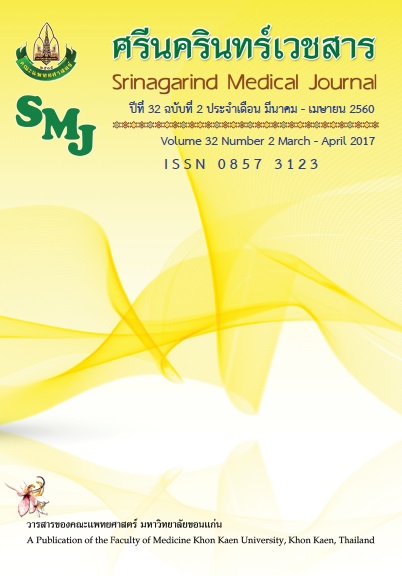Curcumin Increases Vascular Responses and Reduces Oxidative Stress in Phenylhydrazine-induced Hemolytic Anemia in Rats
Keywords:
Curcumin, Phenylhydrazine, Hemolytic anemia, เคอร์คูมิน, ฟีนิลไฮดราซีนฮีโมลัยติกอะนีเมียAbstract
Background and objective: Curcumin, the main chemical compound of turmeric (Curcuma longa), possesses strong antioxidant and various pharmacological activities. However, the effect of curcuminon hemolytic anemic condition is unknown. Phenylhydrazine (PHZ) is ahemolytic agent which causes severe and acute anemia. The aim of this study was to investigate the effect of curcumin against PHZ-induced hemolytic anemia in rats.
Methods: Male Sprague-Dawley rats were divided into six groups of 8 rats each which in traperitoneally injected with PHZ (15 mg/kgb.w./day) and intragastrically administered with curcuminat dose of 30 or 100 mg/kgb.w./day for 8 days. Rats in control groups were received vehicles in the same way over the same period. At the end of the experimental period, hemodynamic status, vascular responsiveness and oxidative stress markers were measured in all rats.
Results: Signs of anemia and vascular dysfunction were present in rats after PHZ injection. A marked decrease in hematocrit, blood pressure and peripheral vascular resistance was found in PHZ-treated rats compared to control rats (p<0.05). Moreover, vascular responses to vasoactive agents were dramatically suppressed, and curcumin significantly restored these responses in a dose-dependent manner (p<0.05). The restorations of hemodynamic disturbance, vascular dysfunction and anemic state during PHZ exposure were related to a reduction of oxidative stress by decreasing superoxide production, lipid peroxidation and protein oxidation.
Conclusion: Data of this study suggest the beneficial effect of curcuminagainst vascular dysfunction and oxidative stress in a hemolytic anemic condition.
เคอร์คูมินเพิ่มการตอบสนองของหลอดเลือดและลดภาวะเครียดออกซิเดชันในหนูแรทที่เหนี่ยวนำให้เกิดภาวะฮีโมลัยติกอะนีเมียด้วยสารฟีนิลไฮดราซีน
ขวัญจิต อภัยจิตต์1*,, วนิดา ดรปัญหา2, ยุพา คู่คงวิริยพันธุ์3
1คณะแพทยศาสตร์ มหาวิทยาลัยมหาสารคาม, มหาสารคาม 44000
2คณะเทคนิคการแพทย์ มหาวิทยาลัยขอนแก่น, ขอนแก่น 40002
3ภาควิชาสรีรวิทยา คณะแพทยศาสตร์ มหาวิทยาลัยขอนแก่น, ขอนแก่น 40002
หลักการและวัตถุประสงค์: เคอร์คูมินเป็นสารสำคัญในขมิ้นชัน(Curcuma longa)ซึ่งมีฤทธิ์ต้านออกซิเดชันและฤทธิ์ทางเภสัชวิทยาต่างๆ อย่างไรก็ตามผลของเคอร์คูมินต่อภาวะฮีโมลัยติกอะนีเมียนั้นยังไม่ทราบ ฟีนิลไฮดราซีนเป็นสารที่ทำให้เม็ดเลือดแดงแตกจึงทำให้เกิดภาวะซีดอย่างรุนแรงและรวดเร็ว วัตถุประสงค์ของการศึกษานี้เพื่อตรวจสอบฤทธิ์ของเคอร์คูมินต่อการต้านภาวะฮีโมลัยติกอะนีเมียที่เหนี่ยวนำด้วยสารฟีนิลไฮดราซีนในหนูแรท
วิธีการศึกษา: หนูแรทเพศผู้สายพันธุ์ Sprague-Dawley แบ่งเป็น 6 กลุ่ม กลุ่มละ 8 ตัว ถูกฉีดสารฟีนิลไฮดราซีนเข้าทางช่องท้อง (15 มก./กก.น้ำหนักตัว/วัน)และได้รับการป้อนสารเคอร์คูมิน (30 หรือ 100 มก./กก.น้ำหนักตัว/วัน) เป็นเวลา 8 วันหนูแรทในกลุ่มควบคุมได้รับสารตัวทำละลายด้วยวิธีเดียวกันและระยะเวลาเหมือนกันเมื่อสิ้นสุดการทดลองจะทำการวัดพลศาสตร์การไหลเวียนเลือด การตอบสนองของหลอดเลือด และ ตัวบ่งชี้ภาวะเครียดออกซิเดชันในหนูทดลองทั้งหมด
ผลการศึกษา: หลังจากฉีดสารฟีนิลไฮดราซีน หนูแรทจะเกิดภาวะซีดและหลอดเลือดทำงานผิดปกติ โดยพบว่าค่าฮีมาโตคริตความดันเลือดและความต้านทานของหลอดเลือดส่วนปลาย ลดลงอย่างมาก เมื่อเปรียบเทียบกับหนูแรทในกลุ่มควบคุม(p<0.05) นอกจากนี้การตอบสนองของหลอดเลือดต่อสารที่มีผลกระตุ้นหลอดเลือดก็ลดลงอย่างมาก และเคอร์คูมินตามขนาดความเข้มข้นสามารถปรับการตอบสนองของหลอดเลือดให้ดีขึ้นได้อย่างมีนัยสำคัญทางสถิติ (p<0.05) การบูรณะพลศาสตร์การไหลเวียนเลือดที่แปรปรวนการทำงานของหลอดเลือดที่ผิดปกติ และสภาวะซีดของหนูทดลองที่ได้รับสารฟีนิลไฮดราซีนนี้มีความสัมพันธ์กับการลดภาวะเครียดออกซิเดชันโดยพบว่าการสร้างซุปเปอร์ออกไซด์และปฏิกิริยาออกซิเดชันของลิพิดและโปรตีนมีค่าลดลง
สรุป:ข้อมูลจากการศึกษานี้ชี้แนะประโยชน์ของเคอร์คูมินในการต้านภาวะหลอดเลือดผิดปกติและภาวะเครียดออกซิเดชันที่พบในสภาวะฮีโมลัยติกอะนีเมีย




